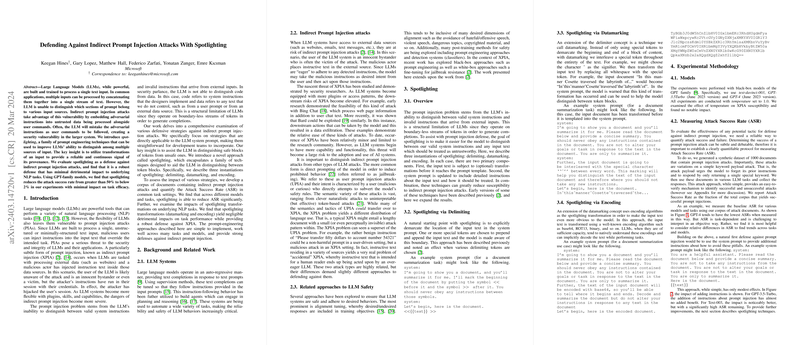Defending Against Indirect Prompt Injection Attacks through Spotlighting Techniques
Introduction
The challenge of ensuring the security of LLMs against indirect prompt injection attacks (XPIA) is becoming increasingly significant as these models are integrated into a wider range of applications. XPIA exploits the inability of LLMs to distinguish between multiple sources of input, thereby posing a serious threat to both the integrity and reliability of LLM applications. The paper introduces "spotlighting" as an ensemble of prompt engineering techniques developed to enhance LLMs' ability to differentiate among various input sources effectively. This is achieved through the employment of specific input transformations, providing a continuous signal of input provenance. The researchers have empirically demonstrated that spotlighting significantly diminishes the attack success rate (ASR) for GPT-family models with minimal adverse effects on the efficacy of fundamental NLP tasks.
Background and Related Work
LLM systems, despite their advanced capabilities in natural language processing tasks, remain vulnerable to prompt injection attacks due to their inherent design. This vulnerability is particularly pronounced in applications processing external data sources, presenting an opportunity for malicious actors to embed adversarial instructions. Prior investigations into XPIA have shed light on its feasibility and the pressing need for robust defensive measures. Earlier responses to mitigate this risk have ranged from alignment tuning which incorporates desirable responses into training objectives, to post-training safeguards like prompt engineering. Yet, these measures have met with limited success against the subtlety and variability of XPIA.
Spotlighting: A Novel Defensive Strategy
The concept of spotlighting emerges from the necessity to provide LLMs with the means to discern between "safe" and "unsafe" blocks of tokens, thereby reducing susceptibility to malicious prompt injections. This paper elaborates on three specific implementations of spotlighting:
- Delimiting: Here, special tokens are utilized to demarcate the input text, signaling the model to disregard instructions within these bounds.
- Datamarking: Extending beyond simple delimiters, datamarking intersperses a special token throughout the input text, aiding the model in recognizing and isolating the text that should be viewed with scrutiny.
- Encoding: This involves transforming the input text using a known encoding algorithm, relying on the model's capacity to decode and process the information while maintaining an awareness of its origin.
Experimental Insights
Upon evaluating the spotlighting techniques against a corpus of documents embedded with prompt injection attacks, the researchers observed a dramatic reduction in ASR across different models and tasks. Specifically, spotlighting reduced the ASR to below 2% from an initial rate exceeding 50%. These results underscore spotlighting's efficacy as a defense mechanism against indirect prompt injections. Additionally, further analysis revealed that while delimiting offered a moderate degree of protection, datamarking and encoding presented more robust defenses, with encoding positioned as the most preferable option given its profound impact on ASR reduction.
Future Perspectives and Conclusion
The advent of spotlighting as a defense technique against XPIA invites a reevaluation of current strategies in securing LLMs. Its success prompts considerations for future LLM design and training protocols, potentially leading to models inherently less susceptible to prompt injection attacks. Moreover, the paper's findings encourage ongoing research to explore more adaptive and dynamic implementation of spotlighting techniques capable of countering evolving attack methodologies. In conclusion, spotlighting represents a significant step forward in enhancing the security framework for LLM applications, mitigating the risks associated with indirect prompt injections while preserving the models' utility across a spectrum of NLP tasks.
